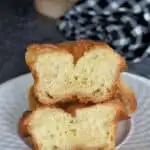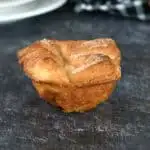Homemade Kouign-Amann
Kouign-Amann is a crisp, buttery, sweet and delicious treat made with layers of yeasted dough, butter and sugar. No exaggeration, this might be the most delicious pastry I’ve ever tasted.
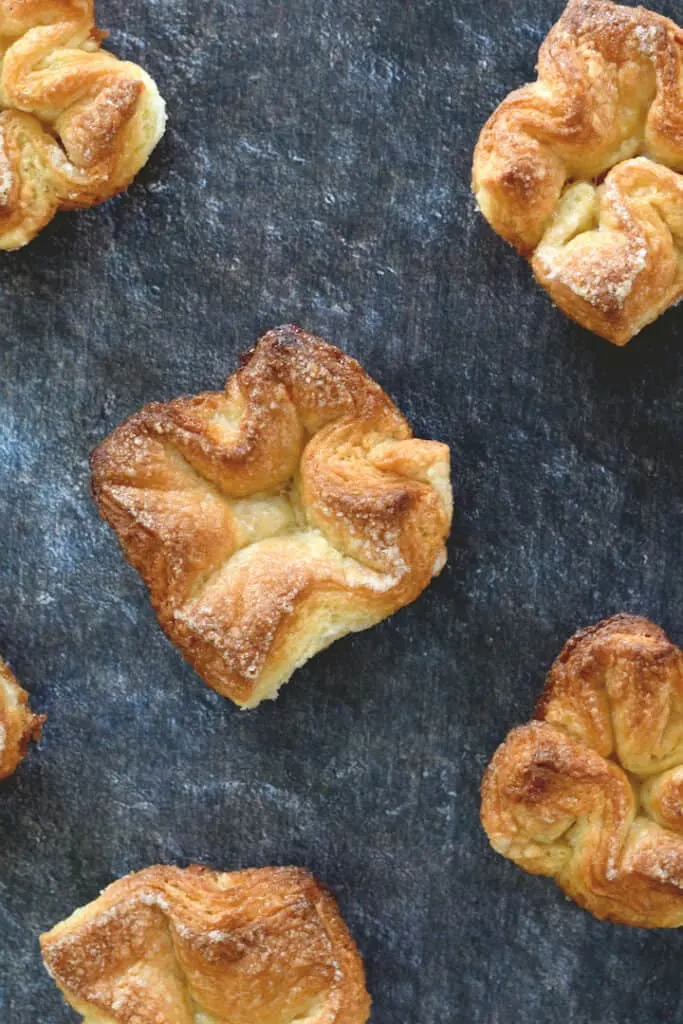
Table of contents
Have you heard of Kouign-Amann? This French pastry is a real gem. The name comes from the Breton words for cake (kouign) and butter (amann). I mean, seriously, how could that not be heavenly?
Back in the day, Breton bakers would take a bit of unbaked bread dough and layer it with lots of butter and sugar. It was simply formed into a round cake and baked.
That means Kouign-Amann is a so-called “laminated” dough. What’s a laminated dough?
Take a big block of solid butter and wrap it with pastry dough. Then roll, fold, roll, fold, creating layers of dough separated by the butter. Croissants, Puff Pastry and Danish pastry are also made with laminated dough.
I’ll show you how to make individual Kouign-Amann as well as the traditional large round cake.
Ingredients:
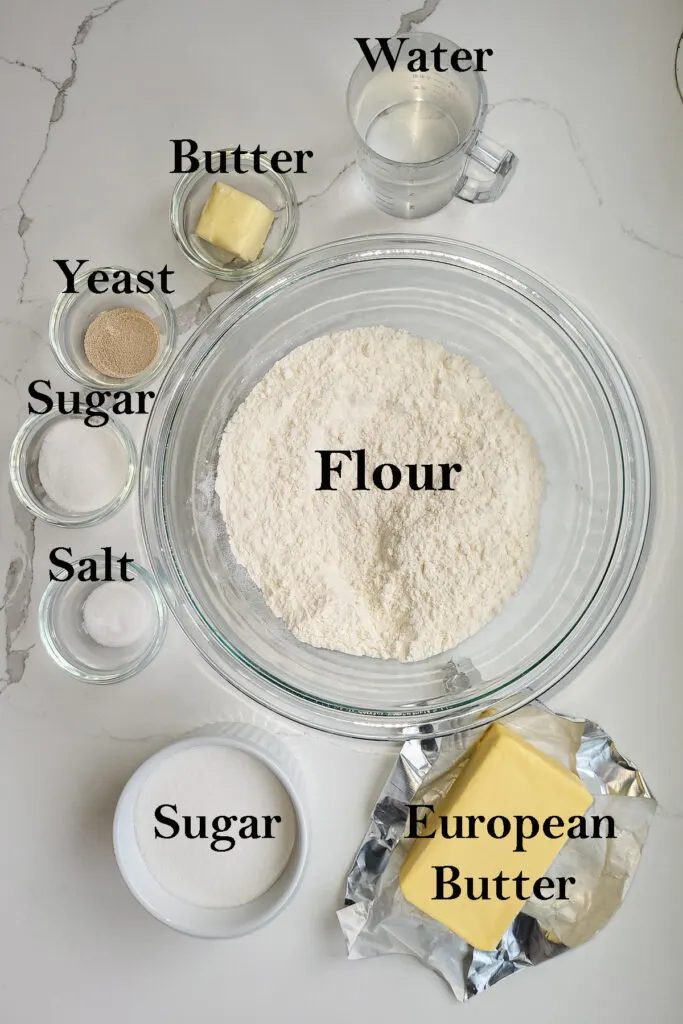
Ingredient Notes
- All Purpose Flour – All purpose flour has a medium protein content which is perfect for making this laminated dough. Enough gluten forms to hold in the butter, but the dough is still tender.
- Instant Yeast – I prefer instant yeast to rapid rise yeast for a slightly slower rising.
- Granulated Sugar – The sugar will combine with the melted butter to form layers of dough and will caramelize on the exterior of the Kouign Amann.
- European Butter – European butter has less water than American butter. American butter is more brittle and doesn’t spread into the layers of dough as easily. You can use American butter for this recipe. Just make sure the butter is at room temperature when you laminate the dough.
How to make Kouign-Amann
How to make Kouign-Amann Dough:
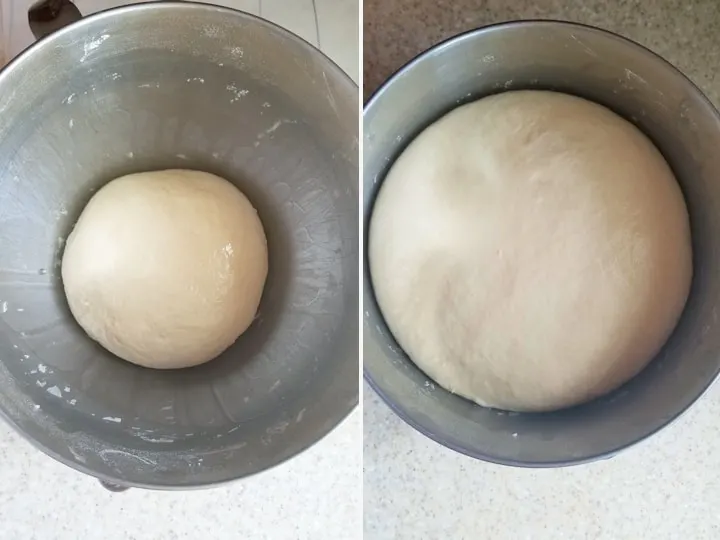
- Make the enriched yeast dough and set it aside to rise.
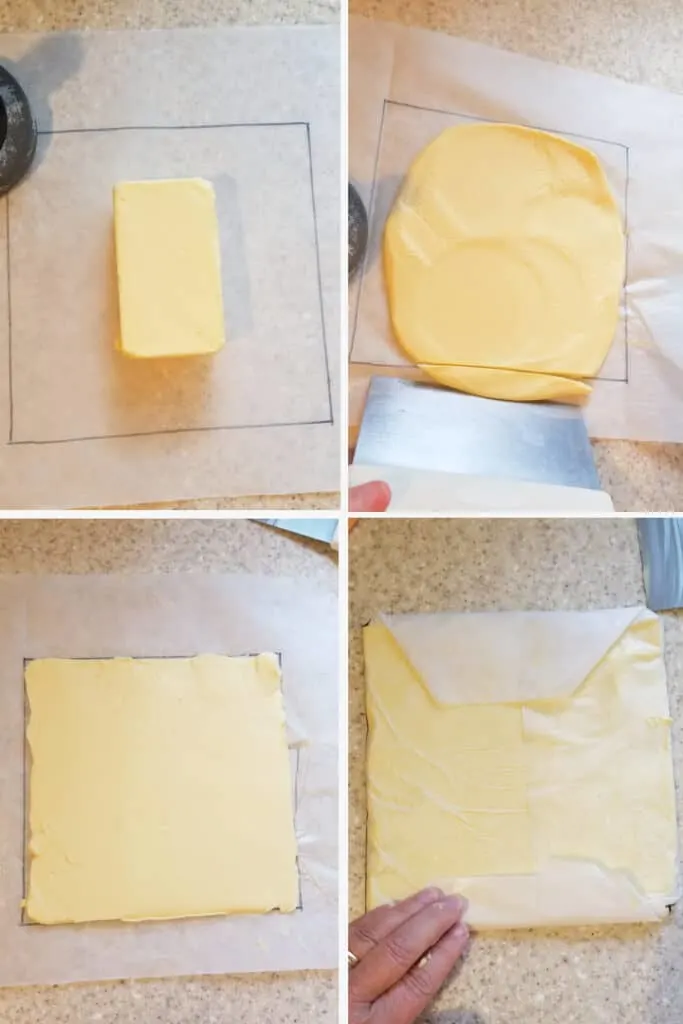
- While the dough rises, make the butter packet
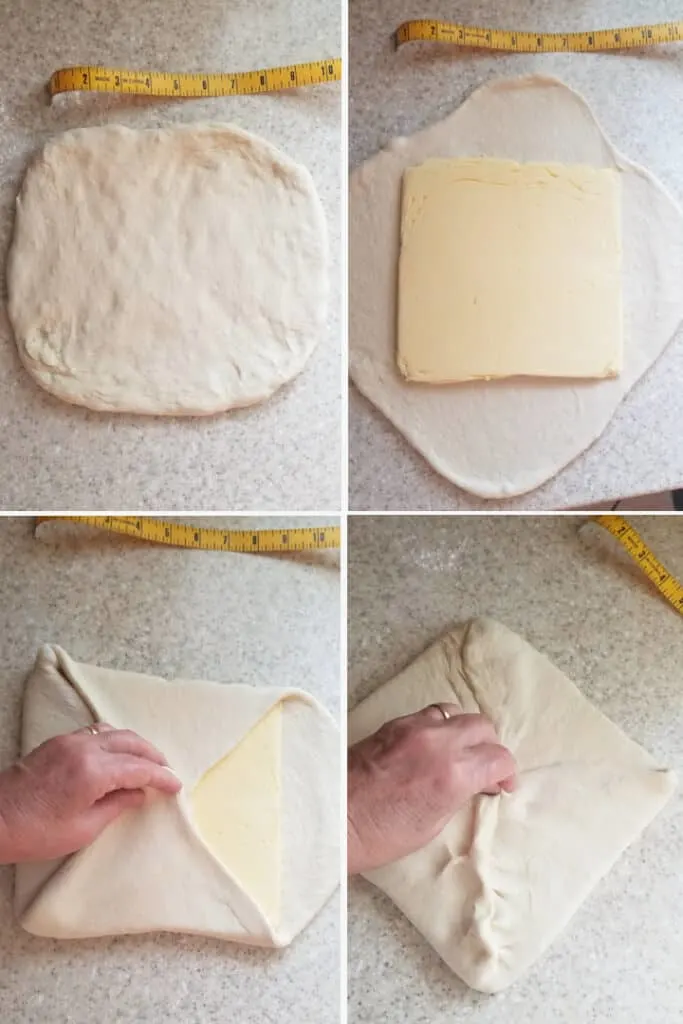
- Pat the dough to a 10″ square.
- Make four flaps from the sides and set the butter packet in the center.
- Fold the flaps over the butter
- Pinch the seams and pat the dough flat.
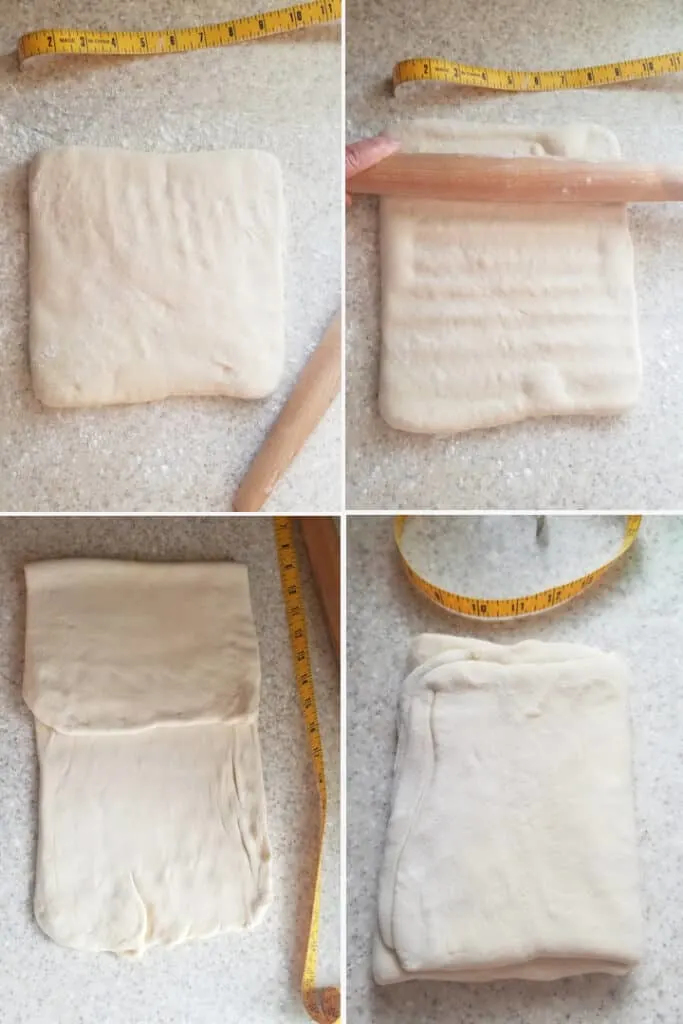
- Set the dough onto a lightly floured surface.
- Use the rolling pin to press on the dough before rolling.
- Fold the dough like a letter.
- Repeat for a second “turn”.
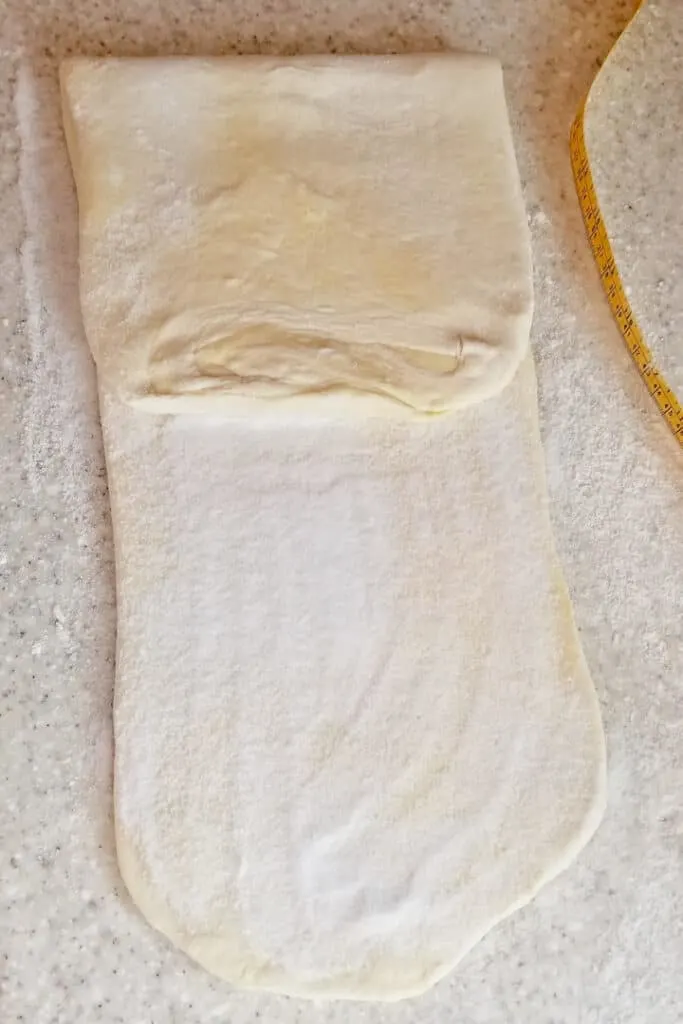
- Do two more turns like the first two, adding a layer of sugar before folding.
How to shape individual Kouign-Amann:
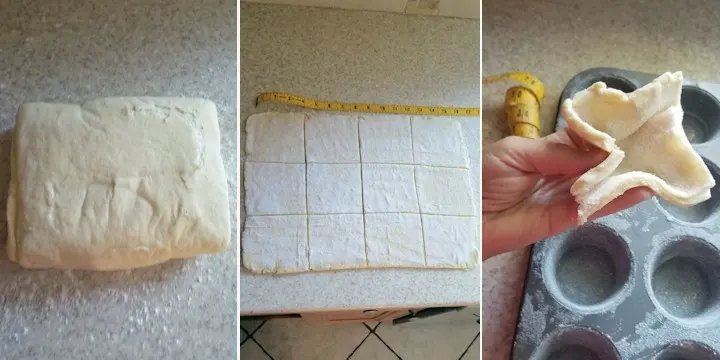
- Chill the dough before rolling.
- Roll to a 12″x 16″ rectangle, sprinkle with sugar and cut into 4″ squares.
- Pinch the sides of the squares to form the Kouign-Amann and set into the prepared pan.
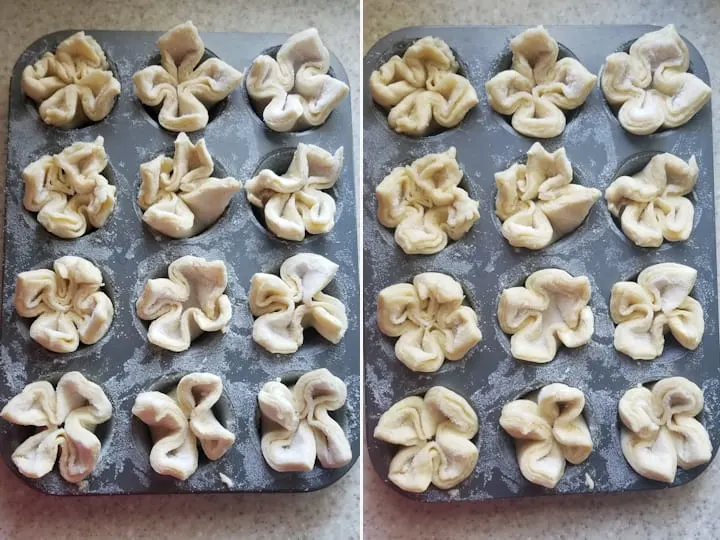
- Set the pastries aside to rise. They won’t double, but should puff and fill the cups.
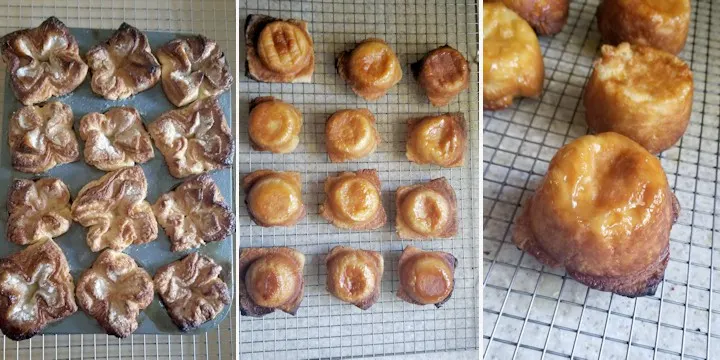
- Remove the Kouign-Amann from the pans immediately or they will stick. Cool upside down.
How to make a Kouign-Amann Cake:
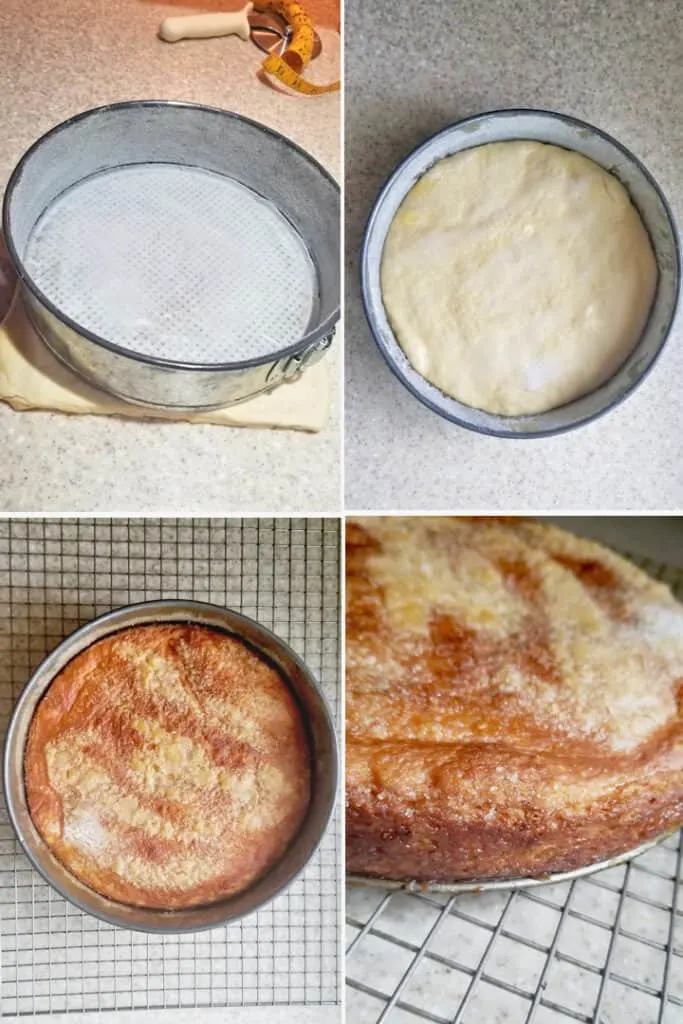
- Roll the chilled dough to a 10″ square.
- Trim off the corners and fit the dough into the prepared springform pan. Set aside to rise.
- Bake 45-50 minutes.
- Immediately release the cake from the pan and cool before serving.
FAQs about Kouign Amann:
You will get good results with either type of butter. European butter is a little easier for laminating since it is less brittle than American butter.
For this recipe salted butter is recommended. The salt balances out the sweetness of the caramelized sugar. If you use unsalted butter sprinkle a 1/2 teaspoon of salt over the butter packet before laminating the dough.
Kouign-Amann can be kept at room temperature for 1-2 days, but is best the day it is baked.
Yes, they freeze beautifully.
After a day at room temperature, or after freezing, the best way to revive the texture of the Kouign-Amann is to warm it gently in a 200°F oven for 5-10 minutes.
Absolutely! Visit this post for a Sourdough Kouign-Amann recipe.
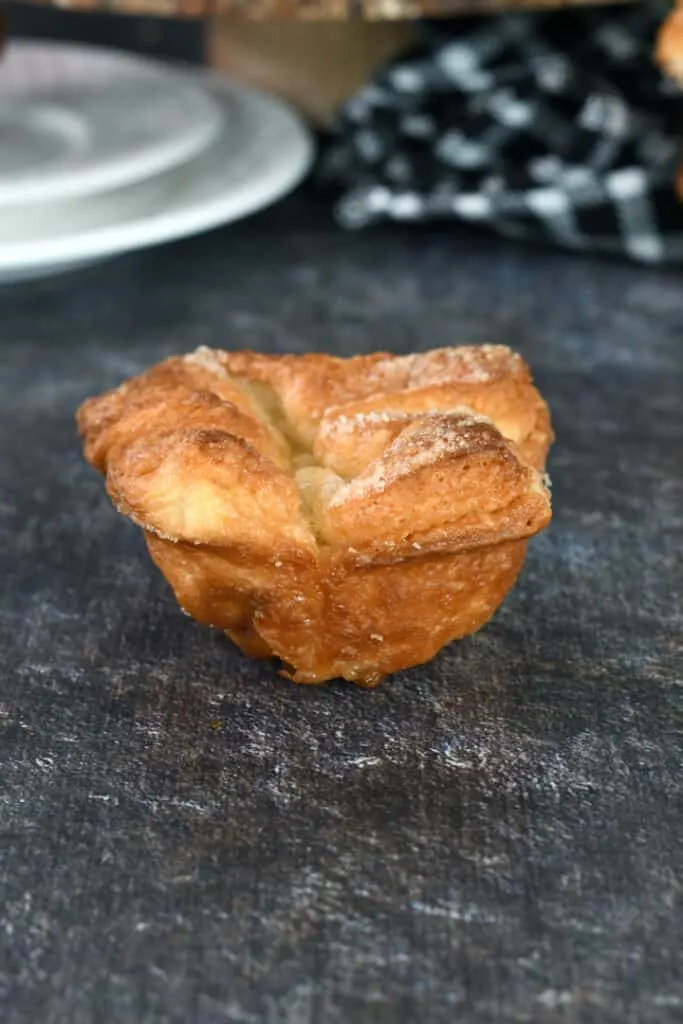
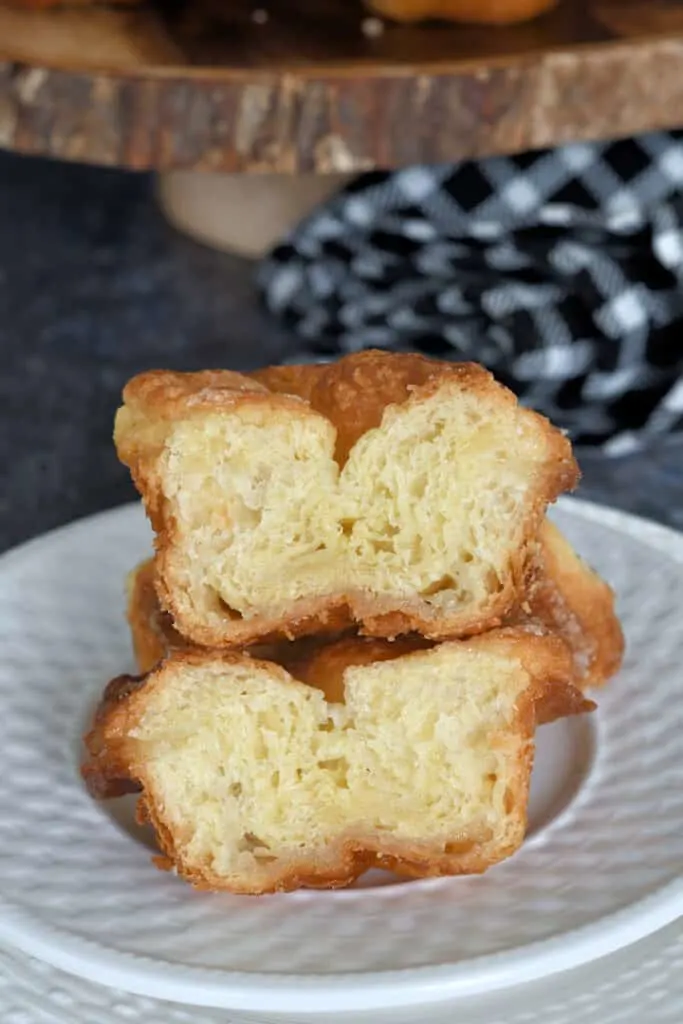
If you love classic French pastries (and I know you do), here are a few great recipes you’ll want to try; Caneles de Bordeaux, Marjolaine, Financiers, Classic Cream Puffs, Chocolate Eclairs, French Apple Tart, Creme Brulee, Baba au Rhum, Merveilleux and airy Chocolate Genoise.
If you love this recipe as much as I do, I’d really appreciate a star rating and a quick comment. Ratings and comments help my recipes show in search results. Thanks!
Homemade Kouign-Amann Recipe
Ingredients
Dough
- 6 ounces warm water (3/4 cup)
- 2 ¼ teaspoons instant dry yeast
- 1 ½ tablespoons granulated sugar
- 10 ounces all purpose flour (2 cups, see note)
- 1 teaspoon table salt
- 1 ounce salted European butter (room temperature)
Laminating
- 8 ounces salted European butter (room temperature)
- 8 ounces granulated sugar (1 cup)
Instructions
Dough
- In a measuring cup, mix the water with the yeast and the sugar.6 ounces warm water, 2 ¼ teaspoons instant dry yeast, 1 ½ tablespoons granulated sugar
- Place the flour and salt in the bowl of a stand mixer with the paddle attachment or into a large mixing bowl. With the mixer running, toss in the softened butter. Run the mixer on low briefly to distribute the butter. If working by hand, work in the butter with your fingers.10 ounces all purpose flour, 1 teaspoon table salt, 1 ounce salted European butter
- With the mixer running on low, add the liquid all at once and mix until it is mostly absorbed. Switch to the dough hook. If working by hand stir the liquid in until it’s mostly absorbed.
- Knead on medium for 5 minutes. The dough should clear the sides of the bowl and cling to the hook. Alternately, knead by hand for 5 minutes until the dough is smooth and supple.
- Transfer the dough to a lightly oiled bowl, turning once to coat the dough. Cover the bowl and leave the dough to rise at room temperature until double in size, about 1-1 ½ hours. Meanwhile, prepare the butter packet.
Butter Packet
- Draw an 8" square in the center of a ½ sheet size parchment paper. Flip the paper over so the ink is on the back.
- Place the butter in the middle of the square. Fold the parchment over the butter. Use a rolling pin or other heavy object (I use the flat side of a meat tenderizer) to flatten the butter to fill the 8"x 8" square. You can lift the paper if it sticks. Trim and rearrange the edges of the butter as needed. Fold the butter into the parchment and place in the refrigerator. The butter should be firm and cool but a little flexible for layering into the dough.8 ounces salted European butter
Laminate
- Turn the dough out onto a lightly floured surface. Do not knead out the air. Pat the dough to a 10" square and pull from each of the four sides to form a flap of dough, leaving the center thicker than the flaps. You should end up with a square with four "flaps" coming out from the sides.
- Unwrap the butter packet and place it in the middle of the square. Fold the flaps so they overlap and enclose the butter, pinching in the corners as necessary to glue the seams together. You should now have an 8" square of dough with the butter enclosed.
- Use the rolling pin to gently press on the square to flatten it. Roll the dough to a 8" x 24" rectangle. Take your time to roll gently and evenly so the butter stays in one layer in the dough.
- Orient the dough so the long side of the rectangle is facing you. Brush off any excess flour. Fold the right ⅓ of the dough towards the middle then fold the left ⅓ of dough over enclosing it like a letter. This is the first "turn". At this point if the dough is very tight or the butter is soft, refrigerate for 30 minutes. If the dough is still easy to work and the butter is cold go ahead with the next step.
- Orient the dough so the closed edge is on the top side and the open edge is facing you. Roll the dough to an 8" x 24" rectangle. Brush off any excess flour and again fold the dough like a letter. This is the second "turn". Set the dough on a sheet pan, cover with plastic and refrigerate at least 30 minutes.
- Remove the dough from the refrigerator. On a lightly floured surface, roll the dough to an 8" x 24" rectangle. Sprinkle ⅓ cup of granulated sugar evenly over the dough. Fold the dough like a letter. At this point if the dough is very tight or the butter is soft, refrigerate for 30 minutes. If the dough is still easy to work and the butter is cold go ahead with the next step.8 ounces granulated sugar
- Remove the dough from the refrigerator. Roll the dough to an 8" x 24" rectangle. Sprinkle ⅓ cup of the granulated sugar evenly over the dough. Fold the dough like a letter. Wrap the dough and place it in the refrigerator for at least 2 hours. I like to leave it overnight and finish making the pastries in the morning.
Assembly
- Generously butter a 10” round springform cake pan and line the bottom with a round of parchment OR butter a 6 cup jumbo muffin pan OR a 12 cup standard muffin pan. Dust with sugar to coat. Shake out any excess.
- If using a 10” round pan, roll the dough to a 10" square, Trim the corners to form a 10" round and set it into the pan. Sprinkle 2 tablespoons of sugar over the dough. Cover the pan and leave the dough to rise for 1 – 1 ½ hours. (The dough scraps can be formed into a loose round and baked as a treat for the chef.)
- If using a jumbo muffin pan, lightly sprinkle the work surface with granulated sugar and roll the dough to a 15" x 10" rectangle. Sprinkle 2 tablespoons of sugar over the top of the dough and pat it in with your hands. Use a pizza cutter or sharp knife to cut the dough into a 3×2 grid. You will now have six 5" squares.
- If using a standard muffin pan, lightly sprinkle the work surface with granulated sugar and roll the dough out to a 16" x 12" rectangle. Sprinkle 2 tablespoons of sugar over the top of the dough and pat it in with your hands. Use a pizza cutter or sharp knife to cut the dough into a 3×4 grid. You will now have twelve 4" squares.
- Grasp the 4 sides of a square and bring them together in the center. Set the dough into a muffin cup with the points up (see photo). Repeat with the other squares. Cover the tray and leave it to rise for 1 – 1 ½ hours. The pastries will not double in size but should come to room temperature and puff up a bit to fill the pan.
- Meanwhile, preheat the oven to 375 °F (350 °F for 10" cake). Place a sheet of aluminum foil on the bottom rack of the oven to catch butter and sugar overflow.
- Bake the pastries in the preheated oven until golden brown, about 30 minutes for standard muffins, 35 minutes for jumbo muffins and 45-50 minutes for a 10" round. The center of the 10" round should feel quite firm when you press on the top.
- As soon as they come out of the oven, flip the pan to release the pastries onto a cooling rack. If you find the muffins in the center cups of the pan are not well browned on the bottom, put them back into the pan and bake for another 5-7 minutes. Allow them to cool completely, upside-down. For the 10" pan, as soon as the cake comes out of the oven run a paring knife around the sides and release the sides of the pan. Cool completely before removing the bottom of the pan and the parchment.
Would you like to save this recipe?
As an Amazon Associate and member of other affiliate programs, I earn from qualifying purchases.

